
Create an Amazon Business Account
Curtiss Wright Failures

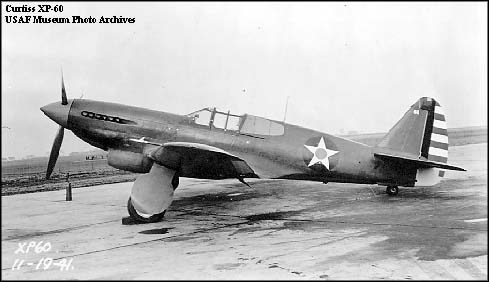
The XP-60 evolved from the Curtiss XP-53, which was designed to
replace the P-40. The XP-53 was essentially a P-40 airframe that
was reworked to fit the Continental XIV-1430-3 inverted V engine.
The wing was somewhat redesigned to incorporate an 8 gun battery
of machine guns. As work on the prototype was nearing completion,
the Army decided that it wanted to evaluate one of the XP-53's
fitted with a Merlin engine. The second airframe was designated
the XP-60 and it was fitted with a Merlin 28 engine. Curtiss took
the opportunity to further refine the airframe. The XP-60 flew
for the first time on September 18, 1941. As the test program ran
it's course, the Air Corps, concerned about Packard Merlin engine
avilability, made a quick decision to switch to a turbo-charged
Allison V-1710-75 powerplant. This variant was designated as the
XP-60A. No guns were ever fitted to the XP-60 even though designed to carry eight.
SPECIFICATIONS (XP-60)
Span: 41 ft. 5 in.
Length: 33 ft. 4 in.
Height: 14 ft. 4 in.
Weight: 7,010 lbs. empty/9,350 lbs. gross.
Armament: None.
Engine: Packard V-1650-1 "Merlin" of 1,300 hp.
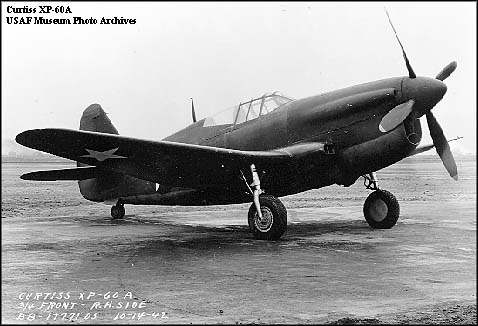
Curtiss was quite concerned that the Allison powered XP-60A would
not meet Air Force requirements. They brought their concerns to
the attention of the Army who made a new proposal. Two additional
aircraft were to be built. Designated the XP-60B, one prototype
would be equipped with a Wright Turbo-charger (the XP-60A used a G.E.
turbo). The next prototype would be fitted with the new Chrysler
XIV-2220 engine. Curtiss, aware of the development problems with
the Chrysler, proposed substituting the Pratt & Whitney R-2800
with new contra-rotating propellers (a common feature of late war
Curtiss designs).The AAF agreed to this and this variant was designated
as the XP-60C. The XP-60A did, indeed, fail to meet published AAF
requirements
and was abandoned.
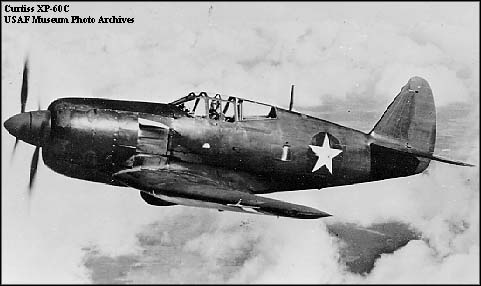
The XP-60C got off to a poor start when it was found that it was
not possible to quickly obtain an engine with the required type of reduction gear necessary for the contra-rotating propellers.
The fighter was then fitted with a more common R-2800-10 engine
with a single four bladed propeller. This unexpected variant was
then
designated the XP-60E. The XP-60C, with the proper R-2800-53 finally
installed, finally flew in late January 1943. The USAAF informed
Curtiss that they had four days to get the plane to Patterson
field for service trials. The AAF, undoubtably not happy with the
constant delays, was giving Curtiss an impossible deadline to
meet.
The XP-60 was hastily prepared and flown off to the trials, and it was far from ready for AAF evaluation. The expected result was obtained. The Army was not at all happy with the plane and informed Curtiss that they no longer held any interest in the project.
Note: The original XP-60 was later re-fitted with a Merlin 61 engine and was designated the XP-60D. It was not a success.
SPECIFICATIONS (XP-60C)
Span: 41 ft. 3.75 in.
Length: 33 ft. 11 in.
Height: 12 ft. 4.25 in.
Weight: 8,698 lbs. empty/10,785 lbs. gross
Armament: Four .50-cal. machine guns
Engine: Pratt & Whitney R-2800-53, 2,000 hp
PERFORMANCE (XP-60C)
Maximum speed: 414 mph. at 20,230 feet.
Climb: 6.0 minutes to 20,000 feet.
Service ceiling: 37,900 feet.
Range: 315 miles on internal fuel.
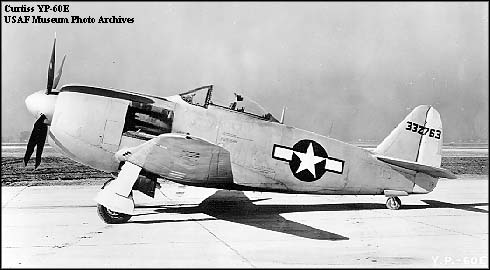
The last hope of obtaining a contract for the XP-60 type lay with
the YP-60E. A development of the troublesome XP-60E, it finally
flew in July 1944, equipped with an P&W R-2800-18 powerplant.
However, its performance was still well below that of the P-47
and P-51. As a result, after just two test flights, it too, was
abandoned.

The Curtiss CW-21 Demon was developed from the CW-19R two seat light
fighter, which in turn was a development of the CW-19L and -19W.
Designed
as a light weight fighter, the CW-21 was powered by a 1,000 hp Wright
R-1820
radial engine. The CW-19R was capable of 190 mph with an initial climb
rate
of 1,890 ft./min. These were reasonably good numbers considering its
rather
meager 350 hp from a Wright R-760E2 powerplant.
The Demon offered much better performance, as one can imagine. Able to attain speeds in the area of 320 mph, with a climb rate of 4,325 ft./min., the CW-21 offered performance in a light weight airframe. Intended from the outset for export sales only, the Demon offered superior flight performance to the Japanese Ki-27 fighter then in use in China. Quite unlike most American designed fighters, the Demon was not a very rugged aircraft, unable to absorb the battle damage of its sibling, the P-40.
The first model of the Demon used a landing gear installation very similar to that employed on the P-40, the wheels rotating and retracting back into the wing. A later variant, the CW-21B had a redesigned landing gear that folded inward and flush with the underside of the wing. Thirty two were ordered by the Chinese government and an additional 24 CW-21A fighters were ordered by the Netherlands for deployment to the Netherlands East Indies in 1940. With the fall of the Netherlands to the Germans, 3 of the earlier were obtained by Gen. Claire Chennault for the American Volunteer Group (the Flying Tigers). All three were written off in crashes while being ferried from Rangoon to Kunming. The pilots, all AVG combat veterans, were not given maps. There were no navigational aids whatsoever. The Demons were not equipped with radios, and the pilots became separated in bad weather. The pilots either crashed or crash landed. Pilot Lacy Mangleburg was unfortunately killed. Flight leader Erik Shilling suffered an engine failure and crash landed on a mountainside.
Later, General Chennault found the flight leader blameless when it was realized that the situation was not the making of the flight leader nor the other pilots. The lack of usable maps and navagation aids would continue to plague the AVG and later, the Allied Air Forces as well.
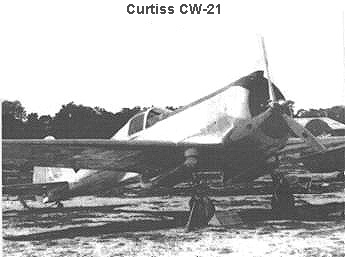
Had the Demons arrived in Kunming, one could only guess at how effective they
would have been. The CW-21’s excellent rate of climb would have allowed the
AVG an opportunity to intercept Japanese raids on their airfields.
Whereas the slow climbing P-40B (Hawk 81-A2) was unable to get to altitude in time to thwart
the Japanese. The trade off would have been in survivability. The Demon’s
light weight construction would not have the P-40’s ability to survive heavy battle
damage. Worse, the Demons were not equipped with self sealing fuel tanks.
The CW-21 Demon, a curious exception to American fighter aircraft design, made virtually no impact in the Pacific war and is generally unknown today.
Specifications:
Length: 27 ft. 2 in.
Height: 8 ft. 11 in.
Wingspan: 35 ft. 0 in.
Weight: 3382 lb (1534 kg), 4500 lb (2041 kg) maximum takeoff
weight.
Armament: Two .30 cal machine guns and two .50 cal machine guns.
Powerplant: Wright R-1820-G5 Radial, 1,000 hp.
Performance:
Range: 630 miles.
Cruise Speed: 282 mph
Max Speed: 315 mph at 17000 ft.
Ceiling: 34,300 ft.
Final note:
Curtiss was still in the aircraft business with several major types in Air Force and Navy service. Yet the prospects of the
company were getting dimmer by the month. In 1945, the newly
built XBT2C lost out to the Douglas XBT2D-1 Skyraider. It was
not long before Curtiss was out of the military aircraft business.
